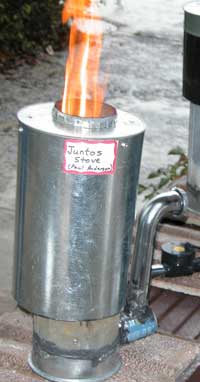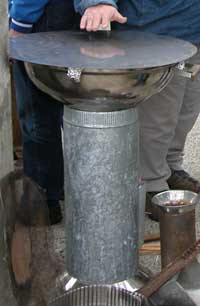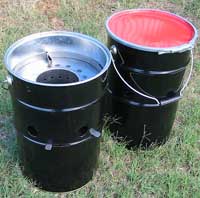


Metal: 3CR12
January 2003
 |
 |
 |
|
Anderson Juntos
|
Aprovecho |
Crispin Pemberton-Pigott (Reply to Paul Anderson)
Type of steel: Thickness of the steel: See: Aprovecho Rocket Stove Design Guide
> 2. When the burning of the char (or charcoal) Further to my information earlier about 3CR12: I have discovered that it is
a. mild steel (common stuff, probably galvanized)
b. 3cr12 (or is it 3CR12 ) has 12 % cromium)
c. stainless steel
Stainless steel is not actually all that resistant to heat. At quite
reachable temperatures the chromium precipitates into little globs leaving
the oxidation sites on the surface 'uncovered' and the iron quickly rusts.
3CR12 rapidly discolours for this reason, having low a chrome content, but
it is cheap and strong. It is very difficult to work with using a hammer.
Thin is probably about 0.35 mm (that is what I remember from discussions in Africa)
The thinnest 3CR12 available I was told by Columbus (the manufacturer) is 1.0mm. They may have plans to roll it further but it is not available.
Thinner than 1.0, one has to go to 420 or 430 grade at a higher price (about
These grades are available down to 0.2mm, so the techie at the can factory told me.
Others at whatever thicknesses are available:
Galvanized sheets are readily available from 0.5 thick and upwards, and
thinner with some delays. The sizes are actually "gauge' thicknesses like 22, 24, 26 etc. with 26 gauge corresponding to 0.5mm. Most sheet metal
articles are made by hand from 24 and 26 gauge galvanized sheets.
Temperature in each cycle:
Anderson: In the pyrolysis stoves of Tom Reed and myself, the pyrolysis temperature get to about 600
to 700 degrees (C, correct?)
I found that 3mm 3CR12 lasts about 4 years in a high heat industrial fire
(our 30Kw Basintuthu boilers). Then they start to burn away at the higher
temperature points (near the top of the secondary air inlet holes). I
expect 3 years of life from the Viro Stove grate and it is 1.2mm but has
lower operating temperatures than those monsters.
I understand Aprovecho has some experience with stainless fire boxes. Can
they offer some life expectancy figures and grades used?
>takes place, the temperatures are about double
>(correct me please.) (and if I put in plenty of air,
>I create a forge that will destroy the stove, I have been told.)
Correct. Try to limit the burning of the charcoal fire to 900 C. There are
already some very strange things going on in the crystals at that
temperature.
Another basic approach is to make sure the stove components do not reach the
temperature of the fire itself.
>Basic research question: Is it worth the money
>to have better steel and thicker steel?
Cast iron is very resistant to heat, much more so that steel, stainless or
not.
avilable in thicknesses down to 0.5mm It should be welded with a 309 rod,
spot welded or bent. It does not make very good folded and hammered joints
as it is prone to cracking when folded tightly.
It is slightly brittle and very strong. When heated parts are assembled in
a tensioned manner, it get annealed at high temperatures and the springyness
disappears. It discolours when heated and eventually rusts but it is very
abrasion resistant, tough to drill and lasts far longer than mild steel in a
fire. I have used it up to 3mm for pots and fire grates for about 4 or 5
years now.
The next cheapest material is 430 sheeting which is available down to 0.4mm
or less. That sells for about US$1.60 a kg (density is 8.0) in
Johannesburg.